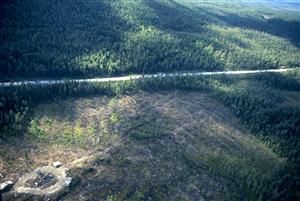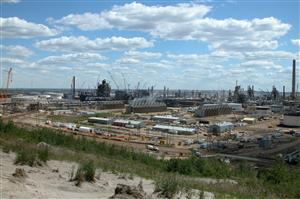Impacts on Boreal Forests and Biodiversity
Major industrial developments in the boreal forest include logging, mining, hydroelectric development, and oil and gas projects. These activities are important to the Canadian economy, but can also have severe impacts on the boreal forest (Lakehead University 2007).
Oil and Gas
The oil sands lie beneath 140,000 km2 of northeastern Alberta. As of December 2007, there were approximately 4,264 oil sands agreements within Alberta, covering an area of 64,919 km2 (Alberta Energy 2008a). Oil and gas developments, like other industrial developments within the boreal forest, have many effects on the landscape and boreal ecosystems. Roads, pipelines, seismic lines, and open pit mines can disturb and displace many wildlife species that depend on large intact landscapes. Between 1995 and 2002, Alberta's energy sector annually cleared an average of 470 km2 of the province's boreal forest (Dyer et al. 2008).
Forestry
The majority of Canada’s forest land is publicly owned, and most is under provincial or territorial jurisdiction (NRCAN 2008). As a result, the provincial government is largely responsible for sustainable resource development; Alberta has approximately 38 million hectares of forest land to manage. Similar to oil and gas developments, forestry impacts the boreal forest through landscape fragmentation and potential effects on hydrology and aquatic ecosystems.
Mining
Mining occurs in all Canadian provinces and territories that share the boreal forest. In Alberta, the mineral industry (excluding oil and gas) is estimated to directly employ approximately 10,000 people. Some of the non-energy minerals mined in Alberta include sand, gravel, sandstone, gold, iron, magnetite, limestone and salt (Alberta Energy 2008b).
Mining activities impact and change the boreal forest. Mining can cause fragmentation of the forest, diversion of water flow, and pollution. As reclamation and remediation of affected landscapes can take decades, mining can have long lasting effects on the boreal ecosystem (Kavanagh 2006).
Hydroelectric Development
Hydroelectric power is generated from the natural flow of water. Electricity is created by the fall of water onto the turning blade of a turbine, which is connected to a generator that converts energy into electricity (Sexton 2004). Hydroelectric developments are found throughout the Canadian boreal forest. Some of the areas particularly influenced are Manitoba, Ontario and Quebec (DUC 2008b). Most of the hydroelectric development in Alberta are located in the southern half of the province. These developments alter the hydrology of river systems and often influence wetlands and associated riparian and upland habitats.










